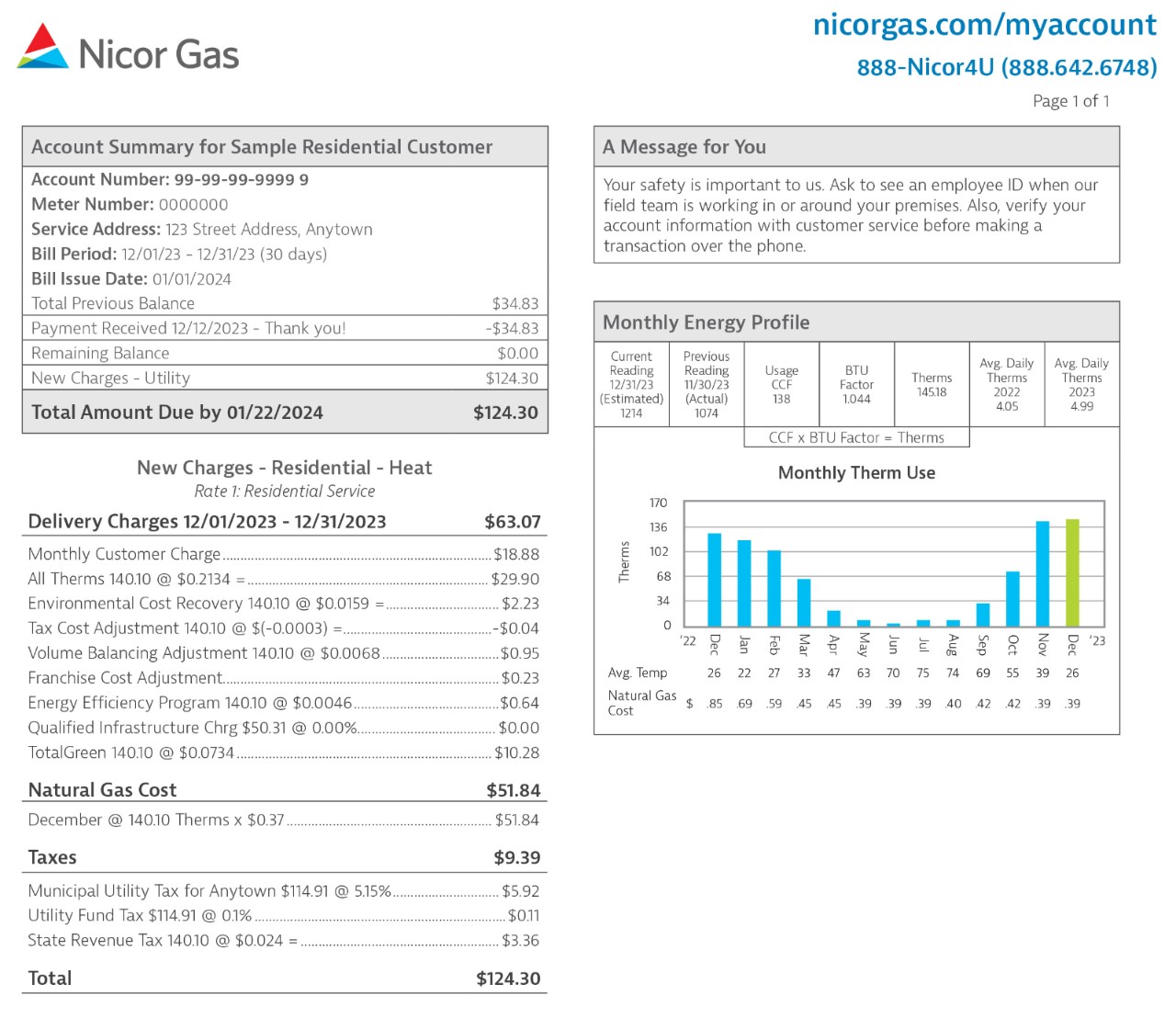Understanding Your Bill
Managing Your Winter Heating Bills
Every customer deserves natural gas they can depend on at a cost they can afford.
While
natural gas remains the best value for your heating needs, costs
typically increase in the winter because your heating system works
harder and runs more often to keep you comfortable. To help manage your
winter heating bills, consider weatherizing your home and following
these additional energy-saving tips.
Your Monthly Natural Gas Bill: Understand Your Charges
Why Your Bill May Vary
Your gas bill will vary from month-to-month for a variety of reasons. Here are some common factors that cause your bill amount to change:
Factors you can't control:
- The cost of gas changes from month to month.
- The number of days in your billing cycle changed slightly.
- Changes in weather caused your heat to come on more often.
Factors you can control:
- You added new gas appliances, like a hot tub or a gas fireplace.
- Your appliance usage increased – most common during holidays, school vacations, when you entertain or have houseguests.
- Your lifestyle changed, such as working at home.
Ways you can help control your gas usage:
- Fix leaky hot water faucets.
- Replace furnace and air conditioning filters.
- Relocate thermostats away from drafty or chilly areas.
- Clean dryer lint traps.
- Replace older, less energy-efficient gas appliances.
- Repair windows that don't close properly. Replace single-pane windows.
- Close fireplace dampers when not in use.
For additional tips and tools to help control your energy usage, check out our Energy Efficiency Program.
To help lessen fluctuations in your bill year-round, consider enrolling in the Budget Plan program.
Energy Profile Information
The Energy Profile section provides information about your current and past natural gas usage.
Current Reading - This represents the current reading of your gas meter, which is determined by one of three methods:
- Actual Meter Reading – your reading was obtained automatically via an upgraded meter with a two-way communications device or by a company meter reader.
- Customer Reading – you reported your meter reading to us.
- Estimated Meter Reading – Nicor Gas estimated your meter reading based on your previous usage and the weather if unable to obtain an actual reading that month.
- Previous Reading – The reading of your gas meter in the last billing period.
Usage CCF - The difference in gas usage (measured in hundreds of cubic feet) between the previous reading and the current reading.
BTU Factor - A factor that expresses the amount of heat content a CCF of gas contains. The BTU factor is applied to convert a volume of gas measured in CCF into therms and may change slightly from month to month.
Average Daily Therms - Your new bill shows your average therm usage for the current billing period and for the same period last year. For billing, your natural gas use is converted from hundreds of cubic feet (CCF) into therms, the basic unit for measuring and billing the amount of natural gas you use. One therm is equal to 100,000 British thermal units (BTU). To determine the number of therms, we multiply your CCF use by the BTU factor. This factor gives the actual heating value of the gas we supply. The BTU factor may vary from month to month, so please refer to your bill for the actual factor being used.
Monthly Therm Use - shows your therm usage for the last 13 months, with the average temperature and natural gas cost (if you purchase your natural gas from Nicor Gas) for each month.

Your Monthly Natural Gas Bill: Understand Your Charges
Current natural gas costs across the United States reflect continued uncertainties and speculation over what the next 12 months hold globally for weather patterns, market conditions and escalating geopolitical events that continue to cause an uptick in the current and forward market for natural gas prices.
Learn MoreHow Is Your Bill Calculated?
Natural Gas Cost (40-50% of your annual bill)
Natural gas costs make up approximately half of your Nicor Gas bill. This is the charge for the gas you use during the billing month. It is calculated by multiplying your gas usage by the average cost per therm we pay to purchase gas supplies. The amount you pay varies monthly based on the cost of gas and the amount you use. Nicor Gas does not profit from gas costs; we pass our cost on to you without markup.
Delivery Charges (45-55% of your annual bill)
Delivery charges shown on your bill consist of the following:
Monthly Customer Charge – a fixed amount that covers our expenses to read your meter, produce your bill and other monthly administrative costs. A small portion of this charge covers various taxes. This charge is incurred even if no gas is used.
Distribution Charges – covers our operating and distribution costs. These charges vary monthly based on the amount of natural gas you use.
Environmental Recovery Cost – covers our cost for the environmental monitoring and clean-up of former manufactured gas facilities. This cost changes periodically, and Nicor Gas does not profit from these charges.
Franchise Cost – covers our cost for municipal franchise agreements. Nicor Gas does not profit from this charge.
Governmental Agency Adjustment – an adjustment for governmental fees and added costs, excluding franchise costs. This cost changes periodically, and Nicor Gas does not profit from these adjustments.
Efficiency Program Charge (Effective June, 2009) – pays for costs related to energy efficiency programs. Nicor Gas does not profit from this charge.
Taxes (5-10% of your annual bill)
Taxes are levied by the State of Illinois and various local municipalities. There are several taxes that may be associated with your natural gas bill, including:
State Revenue Tax – a tax mandated by the state.
Utility Fund Tax – mandated by the state, this tax funds the Illinois Commerce Commission (ICC), which regulates all Illinois utilities.
State Use Tax – a tax for gas purchased outside Illinois for use in Illinois.
Municipal Utility Tax – some municipalities charge a tax based on utility revenues and apply according to the municipality's local ordinance.
Municipal Use Tax – some municipalities charge this tax based on your gas usage.
For more information, please see the back of your bill.
Understanding Degree Days
Heating degree days were developed as a way to relate each day's temperature to the demand for fuel to heat buildings.
Heating degree days are calculated by adding the high and low temperatures of a given day and then dividing by two (to obtain the average temperature). Each degree the average daily temperature falls below 65 degrees represents a heating degree day.
Take a look at the following example:
High temperature: 38
Low temperature: 24
Add the day's high and low temperatures: 38 + 24 = 62
Divide by two: 62 / 2 = 31
The average temperature for the day is 31 degrees.
Subtract the average temperature from 65: 65 - 31 = 34
There are 34 degree days for this day.
Since your individual gas use and your bill can be affected by weather, your Nicor Gas bill shows "total degree days" for both the current billing period and the same period last year so you can compare them.
The National Weather Service has detailed degree day information for various regions of the country, including the Chicago area.




